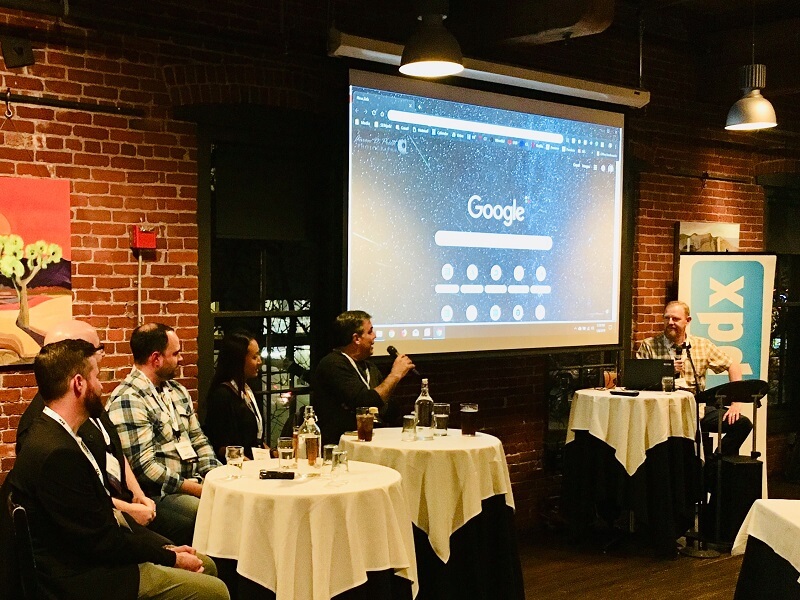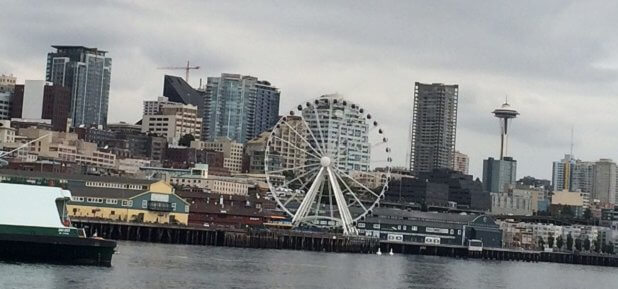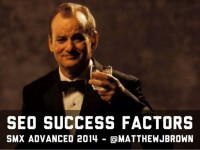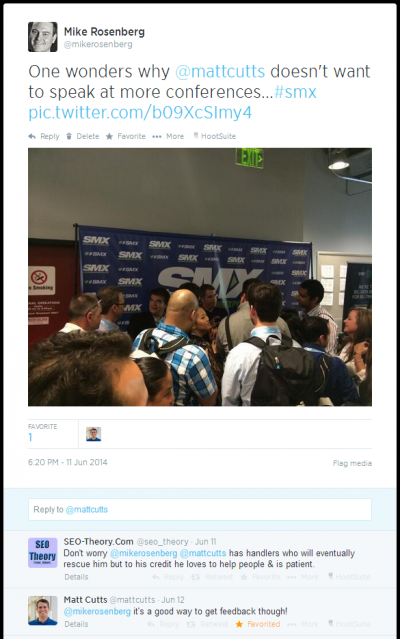Description:
Expert SEMpdx panel featuring a Q&A discussion on “What’s New for 2019 in Digital Marketing.“

I recently attended SEMpdx’s monthly educational event featuring a panel of digital marketing experts. They were tasked with providing insight into what is new (or will be new) in digital marketing for 2019.
As we have done previously when we think a topic may fit our PR Talk audience, we record it.
If you can’t tell, we are focusing PR Talk on digital marketing with the Engage Conference coming up on March 7th & 8th, where Amy will be speaking about Digital PR.
Expert SEMpdx panel featuring a Q&A discussion on “What’s New for 2019 in Digital Marketing.“

Founder & CEO, Avenue

Founder & Lead SEO, Webfor

Founder, Search Commander, Inc.

Assoc Director Demand Gen, Obility

VP of Digital, Vacasa
Matthew Brown
Consultant, SEMpdx Advisory Board Member
What changed in 2018? What did 2018 teach you for 2019?
How did Google’s changes in 2018 effect SEO and Paid Search for B2B industries?
Managing a big enterprise client, did you have an advantage in 2018?
Do you need more content to perform well in specific industries (recipes given as an example)?
As agency owners, how would you change the mix of what you offer your clients in 2019?
What is quality content?
How will the technical elements of SEO matter in 2019?
In regards to schema mark-up, should you mark-up all that you can or just specific things?
Should you delete old content (blog posts) on your site?
What Google My Business (GMB) and local SEO stuff should we know about?
What is your prediction for voice search and the written word in regards to voice search?
How will website privacy impact 2019?
What will Bing do in 2019?
Share something new and improved for 2019 that you are excited about (tools, blogs, etc.)?
Do you have insights on email marketing and SEO podcasts to listen to?
Throughout Oregon and Southwest Washington, PRSA provides members with networking, mentorship, skill building and professional development opportunities – whether you are a new professional fresh out of college or a skilled expert with 20 years in the industry. Check out PRSAoregon.org for more information on how membership can help you grow and connect.
In such a fast-paced, multi-faceted work environment, it can be tough to stay on top of everything. monday is the collaboration tool trusted by businesses of all kinds to help cut down the clutter and streamline productivity. Learn more at monday.com and signup for a free trial. You’ll see in no time why so many teams around the world are choosing monday for their project management needs.
PR Talk listeners can use the coupon code BetterExecute for a 15% discount.
![How To Operate Like a Newsroom [Minicast]](https://www.veracityagency.com/wp-content/uploads/yolanda-sun-44470-unsplash.jpg)
First, a caveat, if you can bring a professional photographer, do it! If you are good at taking photos and videos, skip to the parts about how to submit them or what makes for a good photo opp.
They say a picture is worth a thousand words. Could we be focusing on the wrong thing with all this text? Would you rather have a big picture on the cover/homepage of the New York Times or an article inside? We want both, of course, but the photo is what gets more attention from our audience!
If you are as uncomfortable as Amy, a self-admitted terrible photographer, with taking photos and videos, don’t be. We have had photos and even iPhone videos, taken by this terrible photographer, run on TV.
Of course, you still would rather have the media come (you are more likely to get the story to run), but what if they don’t? You have to fill the role of the reporter even more. Let’s call it HARO, Help a Reporter Out…maybe that’s already taken.
If the news won’t come, serve as an extension of their newsroom by:
Taking photos on your smartphone is easy. Taking really good photos is not. Follow a few basic tips and you will be getting pictures that are good enough to share with the media. Here is a list of what to look out for:
“Take the damn photo!”
Other general (non-technical tips):
Tips for taking videos with a smartphone are basically the same as photos, with a few added suggestions:
See Tips for Creating iPhone Videos for more details or watch this how-to video:
Here are guidelines about when and how to submit your assets:
Submit photos and videos right away to TV, as soon as you can. News gets old really fast and TV typically has a 4 – 5 p.m. air-time, meaning you want to submit by 2 p.m. at the latest. So, if you can, hold your event/photo opp early in the day to give you time to submit to TV.
It is still best to send the day of, but not as imperative. You can be a little less aggressive and send later that day or the next.
Pixels are more important than file size, however:
When Amy talks about using events a lot for getting photos and videos for press coverage, it does not have to be what you’d traditionally call an event. Any time something is happening that is worthy of a photo or video opp, that’s an event.
If you don’t have a cartload of crazy clowns moving into town to promote your thing, you may have to get a little more creative. Here are some ideas that provide good photo opps:
+ Add more to it: incorporate other important things. Talking heads—such as politicians, VIP, donors—talking about important things are always good but visually thin. What can your photo opp players literally DO during their 20 minutes of fame?
While we have explained how easy it is for anyone to take photos and videos for the media, there are certain times you really should call a professional photographer/videographer.
Photo captions are like mini press releases that can get you additional exposure and recognition. Follow these tips when sending to the press:
With these tips and a little practice, you will be operating like your own newsroom in no time!
Throughout Oregon and Southwest Washington, PRSA provides members with networking, mentorship, skill building and professional development opportunities – whether you are a new professional fresh out of college or a skilled expert with 20 years in the industry. Check out PRSAoregon.org for more information on how membership can help you grow and connect.
In such a fast-paced, multi-faceted work environment, it can be tough to stay on top of everything. monday is the collaboration tool trusted by businesses of all kinds to help cut down the clutter and streamline productivity. Learn more at monday.com and signup for a free trial. You’ll see in no time why so many teams around the world are choosing monday for their project management needs.
PR Talk listeners can use the coupon code BetterExecute for a 15% discount.
![Kent Lewis: Anvil Media [Podcast]](https://www.veracityagency.com/wp-content/uploads/Kent-PR-Talk-Podcast-800x600.jpg)
Since I seem to be on a digital PR “jag” after presenting on “PR Your Way to the Top of Google” at Engage with my firm also handling the PR for the digital marketing conference in Portland, I thought I’d interview Kent Lewis, President & Founder of Anvil Media, Inc., a measurable search and social marketing agency. You’ll see Kent quoted in publications, speaking at conferences, teaching at Portland State University and hosting webinars as the founder of career enhancement group, pdxMindShare.
After a short time playing nice with traditional PR people, his attitude got him moved “downstairs” to the stepsister company focusing on interactive. His boss literally opened Kent’s first-ever professional review by asking “what’s your problem?” He was banished to the basement of websites before the internet was recognized as a real entity. Working to maximize online coverage for clients, PR people didn’t respect this as “real PR” and even the interactive people had “no use” for Kent because he wasn’t a developer or programmer.
Left to his own devices, Kent launched into unchartered territories as only a true entrepreneur would. Grabbing the attention of forward-thinking colleagues, Kent was asked to take part in launching new firms — Wave Rock Communications and Young & Roehr Group — where he ran the digital side of things.
But that’s old history. Kent has served at the helm of Anvil for almost 18 years. Today the firm steers clear of PR, only working in “pixels” that can bring “measurable” results to clients. While this may cause many of us to scratch our heads, thinking we might want to ditch PR’s ambiguity for this results-oriented approach, Kent’s daily actions point to how much he respects our industry.
1. HARO (Help A Reporter) — Kent is always looking to serve as an expert resource on marketing topics for press. He does this by mining and responding to HARO, a free resource delivering press requests to in-boxes three times per day.
He doesn’t really care if the coverage ends up on an obscure website, he’s after links back to his website. “The single best way to get good quality links to your website is PR coverage,” he reiterates. He also views PR results as a reason to reach out to prospects and essentially “markets the crap out of it.”
2. Speaking — Sharing his knowledge at industry and business conferences about 30 times a year has been Anvil’s best lead generator.
3. Awards — Submitting for relevant industry and local business awards has helped Anvil. They do not pay for award recognition, but are truly gaining authentic pats-on-the-back from awards that aren’t fee-based.
4. Syndicated articles — Kent often writes for 3rd party publications like iMedia and Online Marketing Institute. He’s disciplined about creating efficiency out of each article by maximizing them multiple ways (he calls this SWING).
5. Press releases — Kent’s quarterly press releases aren’t about getting media pick up. Instead, he views them as sales tools and a nonaggressive way of saying “here’s our latest news.” Kent reminds us that many decision makers still don’t understand the difference between a press release that’s posted on the wire versus one that’s picked up by media.
The difference between Kent and a true PR professional, besides the fact that he’s run a successful search and social company for nearly two decades, is that he’s not proactively pitching reporters nor playing the media relations game. He did that once when a midlife business brought him to what he calls his Jerry Maguire moment in 2013. Faced with surmounting business challenges, Kent manically wrote a 40-page company manifesto, resulting in the removal of half his team. What was toned down into a 10-point credo was picked up by the Portland Business Journal from Kent’s media pitching efforts. The article still pulls powerful search rank today. Let this be an inspiration to all PR people to find their own Jerry Maguire moments—on behalf of our clients, our employers, or the companies we own and are trying to elevate.
President and Founder of Anvil Media, Inc., Founder of pdxMindShare, Adjunct Professor at Portland State University, Co-Founder, Past President and Advisory Board Member of SEMpdx, Board Member and Membership Chair of Entrepreneurial Organization (EO) and Executive Committee, Board Member and Marketing Chair for SMART. Kent does a lot!
Connect and follow Kent on social media:
Throughout Oregon and Southwest Washington, PRSA provides members with networking, mentorship, skill building and professional development opportunities – whether you are a new professional fresh out of college or a skilled expert with 20 years in the industry. Check out PRSAoregon.org for more information on how membership can help you grow and connect.
In such a fast-paced, multi-faceted work environment, it can be tough to stay on top of everything. monday is the collaboration tool trusted by businesses of all kinds to help cut down the clutter and streamline productivity. Learn more at monday.com and signup for a free trial. You’ll see in no time why so many teams around the world are choosing monday for their project management needs.
PR Talk listeners can use the coupon code BetterExecute for a 15% discount.
![Linkbuilding Through PR with Carolyn Shelby, Tribune Interactive [Podcast]](https://www.veracityagency.com/wp-content/uploads/CSHEL-Engage-2018-700-x-525.jpg)
As part of our deep dive into all things digital PR, I took advantage of the profound thinkers while I was at Engage. My firm was on its eighth iteration of handling the PR for the digital marketing conference in Portland where I also happened to be presenting on the topic of “PR Your Way to the Top of Google.”
Carolyn Shelby was kind enough to sit down with me after presenting a “He Said, She Said” session with her husband, Dave Rohrer, on SEO. No, she’s not insane enough to start a business with her husband but they do enjoy presenting together. He owns a boutique digital marketing agency in Chicago called North Side Metrics specializing in SEO and PPC. While she is the Director of SEO for Tribune Interactive, which provides digital support for 10 daily newspapers (such as the Chicago Tribune, New York Daily News and the Baltimore Sun), tons of community papers and a handful of foreign newspapers.
At Tribune Interactive, Carolyn oversees all technical aspects to ensure each newspaper communicates with the search engines optimally. Not only does this protect each entity’s search rank, but her policies are also meant to protect Tribune Interactive’s sponsored content clients.
According to Carolyn, if Tribune Interactive allowed sponsored content clients to place as many links as they wanted, the newspapers would turn into what Carolyn calls a “link farm.” This free-for-all can actually damage their clients’ search results, resulting in penalties from Google. She tells us what to look out for in this capacity and explains why some online publications only allow you to link to an author’s biography at the end of a contributed article for example or only to a website’s homepage.
“Google is very sensitive to the concept of buying links. Do not buy backlinks. Not only is it bad, but Tribune Interactive doesn’t want to create the impression that we’ve been buying links.”
Carolyn’s linking policies for sponsored content:
When I asked for some clarification on what this phrase “over-optimized’ meant, Carolyn explained how Google will look at the totality of a website’s back links and the anchor text (the blue part that you click on to be directed to another page/website). Sites are considered over-optimized when the anchor text only links to sales or call-to-action pages. But it isn’t considered over-optimizing when what’s being sold is part of the organization’s name.
About five years ago it seemed that all anyone wanted from PR people was a mediocre press release posted to press release distribution sites. Veracity was one of the first to point out that the resulting “hits” they brought back weren’t real news. Many of them were going to “fake” websites that weren’t related to any news sources at all.
“Google considered it to be a free-for-all link farm. So many people were abusing this, press releases became meaningless. Today we don’t consider links from these sources to have any value at all,” Carolyn says. “Google said it doesn’t matter where your release is. You can only have two links and one must go to your home page. But if you are continuing to abuse it to the point that it affects your backlink profile, you might get penalized.”
This is where real, old-school PR comes back into fashion. Keep in mind that nothing is actually old-school now because most of our work in print and broadcast also ends up online. I’m always talking about the old-school PR mentality when I use this phrase.
When I asked if getting links from high profile sites like the LA Times versus local community newspapers, Carolyn assured me that it’s sometimes even more valuable for locally-based organizations to garner links from community newspapers. Any newspaper appearing in Google News (type its name in Google News to see if it comes up) is valuable. Carolyn goes on to remind us that we all have local hooks (our hometown, college town, etc.) and if we can “re-write the hook” each time to relate to each customized local angle, not only will our chances of landing the story increase, it ensures you won’t have duplicate content out there which is an SEO faux pas.
Tribune Interactive journalists decide where to link within their stories. Carolyn says she encourages them to link internally “because it’s good for the crawlers.” Her one rule is that they cannot link to conversion pages. While she doesn’t change their stories, she will bring something to a journalist’s attention if they’ve done something she disapproves of. We hear a story about how a journalist got fired for being paid to “drop” obscure links to sites having nothing to do with the story they were writing about. So at the end of the day, the buck ultimately stops with Carolyn.
Want to learn more? You can catch Carolyn at The Social Shake-Up — which represents the intersection of marketing, public relations and social — in Atlanta this May 7 – 9.
Carolyn has been professionally designing/building websites and helping businesses of all sizes integrate their offline and online marketing efforts since 1994. She specializes in organic SEO, content marketing, and helping businesses rebuild under-performing (or just ancient) websites while preserving existing inbound links and search engine rankings.
Carolyn is currently the Director of SEO and SEM for Tribune Publishing, and works on the Chicago Tribune, the LA Times, and six other Tribune newspapers including a number of other digital properties around the US.
Connect and follow Carolyn on social media:
Throughout Oregon and Southwest Washington, PRSA provides members with networking, mentorship, skill building and professional development opportunities – whether you are a new professional fresh out of college or a skilled expert with 20 years in the industry. Check out PRSAoregon.org for more information on how membership can help you grow and connect.
In such a fast-paced, multi-faceted work environment, it can be tough to stay on top of everything. monday is the collaboration tool trusted by businesses of all kinds to help cut down the clutter and streamline productivity. Learn more at monday.com and signup for a free trial. You’ll see in no time why so many teams around the world are choosing monday for their project management needs.
PR Talk listeners can use the coupon code BetterExecute for a 15% discount.

There are always a ton of informative presentations and resources presented at SMX Advanced each year. As a six year veteran [I had lost track until seeing a birthday cake for Bing, the year they announced Live Search was re-branding to Bing was the second year I attended], I’ve sat through many presentations and each year get some tidbits and share-able content.
This year, we’ll focus on the presentations I attended and links that I took note of over the two days. My schedule follows (full agenda):
 Matthew Brown provided a bit of caution on his old position of “Mark up ALL THE THINGS?”. You may not want all of your result types to show up depending on what stage searchers are in. For example, video snippets showing up when people are ready to buy and don’t want to learn more about a product can kill Click-Through-Rate (CTR). Top reference from MJB’s preso was to AJ Kohn’s post on Knowledge Graph Optimization: Notorious KGO: Mo’ Entities, Mo’ Traffic.
Matthew Brown provided a bit of caution on his old position of “Mark up ALL THE THINGS?”. You may not want all of your result types to show up depending on what stage searchers are in. For example, video snippets showing up when people are ready to buy and don’t want to learn more about a product can kill Click-Through-Rate (CTR). Top reference from MJB’s preso was to AJ Kohn’s post on Knowledge Graph Optimization: Notorious KGO: Mo’ Entities, Mo’ Traffic.
 Another SEMpdx Advisory Board member Lisa Williams (check the Joan Holloway style gloves) kicked off this Mad Men themed session, complete with one of my favorite Mad Men quotes:
Another SEMpdx Advisory Board member Lisa Williams (check the Joan Holloway style gloves) kicked off this Mad Men themed session, complete with one of my favorite Mad Men quotes:
“If you don’t like what is being said, change the conversation.” — Don Draper
All four presenters provided quality presentations chalk full of good resources. Mike King shared some good social listening tools including IceRocket, Topsy, Social Mention as free options and Radian6, Sprinklr and Sysomos as paid tools in his Social SEO Tactics presentation.
Paid search folks don’t like to share links quite as freely as the SEO and content marketers…imagine that (plus I was a slacker in this presentation and didn’t take notes, sorry). So, just for the fun of it check out Marty’s presentation and try to follow it w/o him screaming at to you…good luck.
A lot of time was spent by this group talking about how to find, remove and/or disavow bad links, as well as some good ideas of where to find new quality links. It was the first mention of “Negative SEO” in the presentations that I attended. Übersuggest was mentioned by Prashant Puri as a good keyword research tool for link building. Link Research Tools and Link Detox got a few mentions as well for people to use to see what negative links they may have and how to start getting them removed.
 You&A With Matt Cutts
You&A With Matt CuttsAs usual this session featured a few Google announcements and a Q&A hosted by Search Engine Land Editor Danny Sullivan and answered by Google’s webspam killer Matt Cutts. Nothing really groundbreaking this year…Matt uses Google+ still (I think the audience probably makes up about half of G+’s active user base), neither Matt or Danny are particularly skilled at throwing stuffed hummingbirds and Google on an android phone can follow a conversational search string via voice commands.
Actually if you want a nice recap, I was sitting near Sugarrae and she was furiously tweeting and taking notes, so go read her post.
That was the end of day one and Matt got swarmed on his way out…but I guess he doesn’t mind. (more…)

I recently found myself buying into the hype of terms like “online PR” and “social PR,” building a list of those in charge of news organizations’ websites or social media channels. What a novel idea! If all I wanted was to land a story on the website or Facebook page of a newspaper or radio/TV station, I could save a huge chunk of time by side-stepping the reporters.
Let’s be honest. Working with reporters can be hard at times. There is still work to be done even after you’ve put just the right combination of wittiness, newsworthiness and timeliness into a story. There is the following up. And following up. And following up. Hitting send in Outlook, Tweet in Twitter or Like in Facebook just isn’t enough. I hardly ever land a story without picking up the dreaded telephone.
But is all of that legwork necessary for the client that’s only after prized links from credible news organizations? Understandably, many clients are only interested in PR as a means to build their SEO. Links from news sites are an SEO’s gold. They are lasting and strong—and truly build a website’s organic SEO. Moreover, Google is getting too smart for the likes of news distribution sites. Not only does spamming the universe with press releases not cut it anymore, it can actually hurt your SEO. But don’t cry over that loss because did it ever get you on sites like NBC or the New York Times?
Now that we are back to square one, why not cut out the middle man and go directly to the source—the powerful being that is in charge of the news organization’s website or social media? Working with that person might be easier because they probably pay more attention to their in-box and might be a bit more savvy in matters like downloading images and incorporating the links you’d want in a story.
However, every time I go down that route I am reminded there really is no such thing as “online” PR. The website content managers do act in an editorial capacity, however they are basically culling through all of their reporters’ completed stories and choosing which ones will make it on the website. Actually most stories will make it on the website, so the website manager’s job might be more focused on how to position each story online.
You might be able to sneak some stories in through the backdoor, but it is rare. More often than not, the way to go about it is by pitching the reporters. If the story is of interest, but not newsworthy enough to make it into the traditional medium, it has a shot of making it into the website through the reporter’s blog. Let’s not forget, some reporters now have huge online followings. So you’d rather have the reporter post it instead of the general webmaster who might not have a following at all.
Now websites serve as an extension—or sometimes even replacement—of the traditional news organization’s main product. If you’ve landed a story in the traditional medium, you are that much closer to getting it online or on the organization’s social media channels. Track your story to make sure. If it does not hit cyberspace, this is when you need to contact your new webmaster or social media friends. You might have to pick up the phone.
![]() Images used under this Creative Commons License.
Images used under this Creative Commons License.